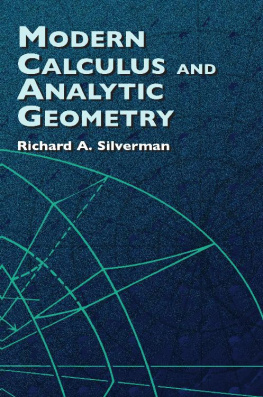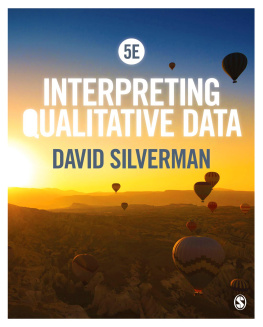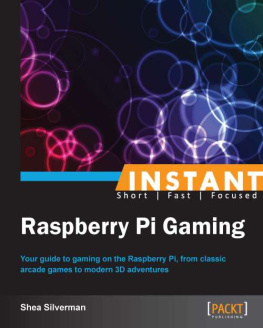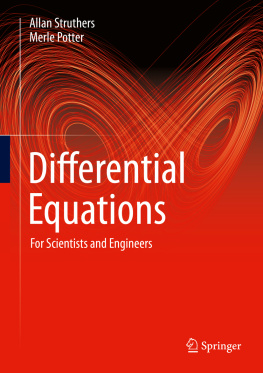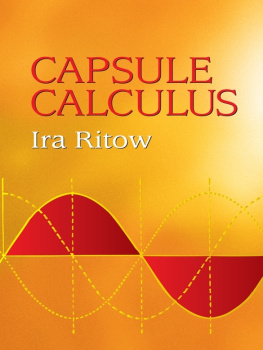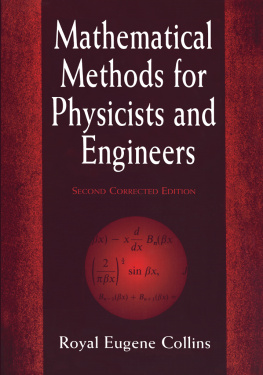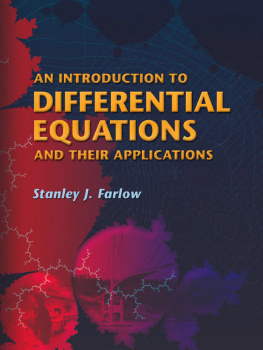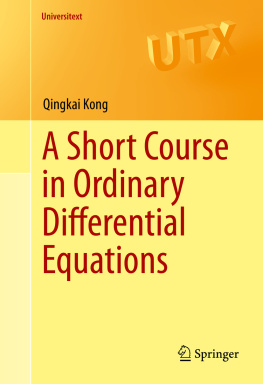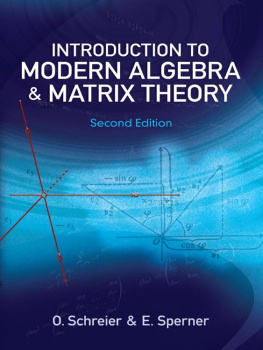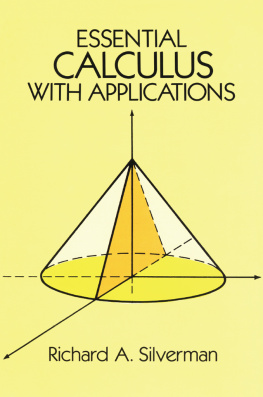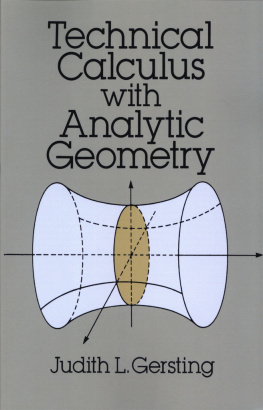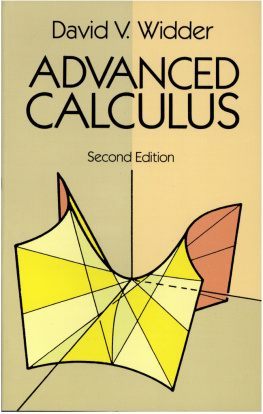MODERN CALCULUS
AND ANALYTIC GEOMETRY
MODERN CALCULUS
AND ANALYTIC GEOMETRY
Richard A. Silverman DOVER PUBLICATIONS, INC.
Mineola, New York
Copyright Copyright 1969 by Richard A. Silverman All rights reserved.
Bibliographical Note This Dover edition, first published in 2002, is a corrected republication of the edition published by The Macmillan Company, New York, 1969.
Library of Congress Cataloging-in-Publication Data Silverman, Richard A. Modern calculus and analytic geometry / Richard A.
Silverman
p. cm. Originally published: New York : Macmillan Co., 1969. Includes index. eISBN 13: 978-0-486-79398-6 1. 2. 2.
Geometry, Analytic. I. Title. QA303.2 .S55 2002
515'.15dc21 2002023778 Manufactured in the United States by Courier Corporation
42100702
www.doverpublications.com To Joan
PREFACE
The philosophy of this book can perhaps be summarized in the following two commandments: Motivate all new ideas, both mathematical and physical and Prove all theorems. Concerning the second precept, it seems to me that the author of a calculus book should avoid recourse to arguments beginning with phrases like Considerations beyond the scope of this book show that... , even if such arguments are accompanied by suitable references to other books. , even if such arguments are accompanied by suitable references to other books.
In the first place, it is unreasonable to assume that the average reader of a calculus book (not a mathematics major) will ever take the appropriate more advanced course. But, more to the point, the presence of too many unproved propositions introduces an atmosphere of expediency which subverts the spirit of a mathematics book, even at this level. After all, how is a student to learn to think for himself (and this includes discovering that plausibility alone is never enough in any science) if he is constantly being exhorted to take things on faith, even things which sound quite reasonable? Fortunately, there is almost always an elementary method of proof, allowing one to avoid all handwaving without getting too fancy. For example, there exists a simple proof of the equality of double integrals and iterated integrals of continuous functions of two variables (see Sec. 98), the legitimacy of term-by-term differentiation and integration of power series can be established without explicitly invoking the concept of uniform convergence (see Sec. 114), and so on.
Some of these proofs may have to be skipped on a first reading or in an abbreviated course, but at least the student knows where to find them stated in familiar language, and whats more, he will not get an exaggerated idea of their difficulty! It will be a rare student who has not already encountered some of the material in Chapters 1 to 3, and an even rarer one who is familiar with all of it. ). The key concept of the limit is confronted squarely in , in sufficient detail to exhibit its full generality. In other words, nontrivial calculations of limits are given, as well as examples illustrating how a function can fail to have a limit at a given point. Continuous functions are studied in Sec. 27, again with examples showing the various ways in which a function can fail to be continuous.
Having mastered the limit concept, the student is more than halfway home to an understanding of the concepts of the derivative and integral, presented in Chapters 5 and 7. In my opinion, the more traditional approach of treating derivatives and integrals first and then picking up the necessary background information about limits, continuity, etc., in a series of flashbacks is counterindicated in a modern treatment of calculus, in which the limit itself is recognized as the central notion. The price for premature exposure of the student to derivatives and integrals is the necessity for repeatedly shoring up his flagging understanding of what these concepts really mean, as he encounters functions which are less and less well-behaved. This can only be prevented by sending him to battle armed with a full grasp of limits and continuity. is a unified treatment of material that is scattered in many books under such headings as applications of the derivative, transcendental functions, underlying theory, basic properties of continuous and differentiable functions, etc. In keeping with the spirit of modern functional analysis, I have organized these topics around the central idea of well-behaved functions.
As already noted, integrals enter the picture in important application of calculus to science and technology. Newtons second law of motion appears in Sec. 53, and the program of showing how the second law leads naturally to the key concepts of work, energy, center of mass, and moments of inertia is begun in Sec. 54 and completed in Secs. 74 and 100. I do not see how these concepts, so intimately associated with calculus, can be brought in as a deus ex machina, as is so often done.
Analytic geometry, touched upon in from a contemporary standpoint emphasizing such concepts as point and coordinate transformations, invariance, etc. Conics are treated in detail, with due regard for improper conics. Calculus methods are used freely in dealing with tangents and areas, both in rectangular and polar coordinates. By the end of , in anticipation of subsequent needs in connection with vector algebra and analytic geometry in three-space and the treatment of Jacobians in Problem Set 104. Thus Secs. 77 to systems of linear equations and their solution both by Cramers rule (when appropriate) and, equally important, by elimination. 77 to systems of linear equations and their solution both by Cramers rule (when appropriate) and, equally important, by elimination.
The differential and integral calculus of functions of several variables is developed in Chapters 12 and 13. Here the reader will find suitable definitions of the terms region and surface, too often left vague and undefined in first courses on calculus. The earlier formal use of the technique of implicit differentiation is justified in Sec. 92, on the implicit function theorem. The treatment of multiple integrals in goes much further than usual in the direction of proving the main results of the subject, but only elementary tools are used. In both Chapters 12 and 13 it is made clear that propositions involving functions of one variable often have counterparts for functions of several variables, which are proved in much the same way.
It is only in Sec. 104, on change of variables in multiple integrals, that it becomes hard to abide by the precept Prove all theorems. Here we inevitably arrive at the boundary between elementary and advanced calculus, by anybodys standards. By the student has the time to spend on perfecting his computational technique, first acquiring LHospitals rule and then Taylors formula. The technique of integrating rational functions is treated in more detail than usual in Sec. 109 to the evaluation of difficult integrals. Sec. 110 is devoted to numerical integration, including proofs of the all-important error estimates. 110 is devoted to numerical integration, including proofs of the all-important error estimates.
This material on integration technique is traditionally placed earlier in most books, at a stage where, in my opinion, the student can more profitably devote his attention to new concepts rather than special tricks. , on infinite series. As already mentioned, avoiding the topic of uniform convergence is no obstacle to giving a full treatment of power series and Taylor series. There are well over 1600 problems, arranged in 115 problem sets, one at the end of each section. A problem number unaccompanied by a page number always refers to a problem at the end of the section where the reference is made. Many problems were drawn from Russian sources in the public domain.
Harder problems are indicated by asterisks, as are problems which pursue certain topics somewhat beyond the needs of a first course on calculus. For example, such things as one-sided derivatives, a curve with no length, and the general formula for the radius of convergence of a power series will be found in starred problems. Thus the book becomes suitable for an honors course if the starred problems are solved and the harder proofs are worked through. Answers to all the odd-numbered problems are given at the end of the book. These answers are often detailed enough to constitute complete solutions, which are meant to be read sooner or later. This is particularly true of starred problems dealing with points of theory.
Next page
